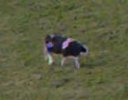Nope. Makes it more stable, for the same reason it makes the aircraft more stable if heavier. Simple physics.
I agree that the physics are simple. I disagree that a more massive gimbal is more desirable.
More inertia simply means a greater force necessary to produce the same acceleration. Wind forces are the same no matter the mass of the drone. So all things being equal, a lighter drone will be displaced more quickly by the same impulse than a heavier drone, which results in greater pitch/roll error than with a heavier drone. You have no control over wind forces.
Yes, agrees with what I said about overall
drone stability.
In contrast, you can engineer the controlled forces through motor power. A heavier drone can be made to respond with pitch/roll angular acceleration just as fast or faster than a lighter drone with more power.
Yes, if the power can be made available without compromising other design objectives, such as weight and battery life.
The gimbal is exactly the same. It can be engineered to react every bit as fast as a lighter gimbal by using more powerful motors. The speed of gimbal movements is a design parameter.
Again, yes, if the power can be made available without compromising other design objectives, such as weight and battery life.
However, external forces on the gimbal are the same regardless of what it weighs. The heavier it is, the less perturbation will result with the same transient impulse, requiring less correction by the stabilizing motors, making it more stable.
Yes, the gimbal is subject to external forces and perturbations. Only a small portion comes from external forces acting directly on the gimbal, primarily wind forces. (We'll ignore birds, trees, and such for now.) A more massive gimbal would be more resistant to being yawed, pitched or rolled
relative to the drone. But correcting those wind effects on the gimbal is a minor task.
The gimbal's primary, and more difficult, job is to directly and immediately compensate for the yaw, pitch, and roll of the drone. If the drone rolls left or right the gimbal must immediately and precisely roll right or left to keep the camera image stable. Same for the other two axes. The faster the gimbal can respond, both starting its movement and stopping its movement, the more stable the camera image. The gimbal needs to accelerate and decelerate quickly. Inertia is not your friend, here.
For better gimbal acceleration, make mass smaller or make force larger. But force comes only at the expense of motor power, which comes at the expense of greater weight and increased energy use from the battery. DJI seems to have minimized the mass of their cameras and gimbals.
But if a more massive gimbal would give better image stabilization, clever owners who need that special rock-steady shot would be attaching fender washers to the bottom of the camera and accepting the reduced flight time due to the added weight.











